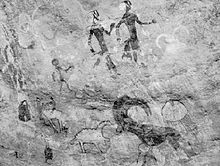Saharan rock art
This article needs additional citations for verification. (June 2010) |
| Rock Art Sites | |
|---|---|
| Location | Algeria |


Saharan rock art is a significant area of archaeological study focusing on the precious treasures carved or painted on the natural rocks found in the central Sahara desert. It is the world's oldest surviving rock art that dates back to tens of thousands of years before the first written languages were created.[citation needed] Africa also has more rock art than any other continent on the planet. The rock art is significant because it shows the culture of our early ancestors. Archaeologists and anthropologist are among those who research evidence of religion and beliefs, as well as the way in which they lived their lives. There are over three thousand sites discovered that have information about Saharan rock art. From the Tibesti massif to the Ahaggar Mountains, the Sahara is an open-air museum containing numerous archaeological sites.
The paintings and carvings in these sites are irreplaceable, yet endangered. More vulnerable rock art that is shown on uncovered rock has already disappeared. Most of the existing rock art today is believed to be 6,000 years old. Although, researchers think that the vanished rock art could have been between 15,000 and 33,000 years old.
Organizations, such as the Saharan Archaeological Research Association SARA[1] are researching and recording as much heritage, while raising awareness of the endangered rock art.
Archaeological sites
Important regions include:
- Cave of Swimmers and Cave of Beasts caves area, Gilf Kebir area, Egypt
- Tibesti, Chad
- Ennedi, Chad
- Mesak Settafet, Libya
- Tadrart Acacus, Libya
- Tassili n'Ajjer, Algeria
- South Oran, Algeria
- Djelfa, Algeria
- Ahaggar, Algeria
- Draa River, Morocco
- Rock art of Figuig, Morocco
- Aïr Mountains, Niger
The cave paintings found at Tassili n'Ajjer, north of Tamanrasset, Algeria, and at other locations depict vibrant and vivid scenes of everyday life in the central North Africa between about 8000 BCE and 4000 BCE, in the Later Stone Age. There are over 15,000 individual pieces of artwork in Tassili n'Ajjer. The art includes paintings and engravings into the rock that depicts the culture of Africans up to 12,000 years ago. They were executed by a hunting people in the Capsian period between 3000 -1900 BC who lived in a savanna region teeming with giant buffalo, elephant, rhinoceros, and hippopotamus, animals that no longer exist in the now-desert area. The pictures provide the most complete record of a prehistoric African culture. The site was originally founded by french anthropologist Henri Lhote 50 years ago, yet researchers are still discovering new artwork.
Research techniques
Archaeologists, anthropologists and other researchers have been studying rock art to gain information about African cultures from the past. Studying the disappearing evidence from the past is difficult. Many photographs are taken of the art so they can be studied further. At the sites, research techniques such as dating the art are made possible through radiometric dating of organic material, as well as carbon dating. Surrounding organic artifacts are used for dating, or residue that is on the rock art itself. [1]
Prehistoric Sahara
Art time periods
- Large Wild Fauna Period (Bubalus Period) - A time when Saharan hunter-gatherer societies made rock art. These images included animals that were hunted or in their surrounding area. Animals such as hippos, rhinos, elephants giraffes, bubalus, aurochs, large antelopes. Many of those animals are unable to exist in the Sahara due to the change in climate over the past several thousand years. There is also pictures of humans that are shown hunting with spears and axes. The artwork portrays not only hunting, but the relationship between humans and animals. Most of the artwork can be found in Tassili n'Ajjer, Algeria.
- Pastoral Period - During this period, humans were depicted using animals as cattle, instead of hunting them. Pictures show cultures herding animals and hunting as well, portrayed through men holding bows. Women and children are in camps where they lived. This style is shown around the Sahara with paintings and engravings. The art shows the society of old African cultures becoming more complex with an economic system. The more cattle owned by the herder, the more wealth and power they had. This period has less artwork from black African peoples, and more from the Mediterranean, presuming that they Africans eventually migrated North away from the changing Saharan climate.
- Horse Period - Humans are shown with horses during this period. Paintings and few engravings have men on horses with weapons, as well as horse-drawn chariots. The people are also dressed in clothing instead of no clothing at all.
- Camel Period - This period is the end of the Saharan rock art from African cultures. Similar to the Horse Period, images of camels are shown. More animals are drawn, such as cattle and goats. Advanced weaponry are also included in the art, men with spears, swords and shields. [2]
See also
References
- ^ a b "Trust For African Rock Art - Prehistoric African Paintings and Engravings". Trust For African Rock Art. Retrieved 2016-11-02.
- ^ Coulson, David; Campbell, Alec. "Rock Art of the Tassili n'Ajjer, Algeria" (PDF). AfricanRockArt.org.
